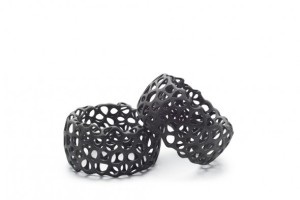
Can HP Make 3-D Printing into a Mass Manufacturing Technique?
Can HP Make 3-D Printing into a Mass Manufacturing Technique?
The tech giant says its new $130,000 printers will produce plastic parts quickly and inexpensively.
Despite the flexibility of 3-D printing, it still cannot compete with conventional injection molding for making large volumes of high-strength plastic parts. Hewlett-Packard says its new printing technology will change that.
Today HP will begin taking orders for systems that print parts in a process it calls Jet Fusion. The company will start shipping the printers, which start at $130,000, in October. It also announced several industrial partners, including BMW and Nike.
Jet Fusion is best compared to laser sintering, in which a laser is used to heat granules of polymer powder and fuse them to build objects layer by layer. Laser sintering can make very strong parts, but it is relatively slow because it relies on a point laser. Aside from prototyping, it is useful mainly for manufacturing small volumes of complicated and often customized parts.
 Sample parts made using HP’s new 3-D printing technology.
Sample parts made using HP’s new 3-D printing technology.
HP says its technology is up to 10 times faster than laser sintering. To achieve these speeds, the company has taken advantage of its expertise in ink-jet printing. In the Jet Fusion process, ink-jet print heads deposit two different inks—a “fusing agent” and a “detailing agent”—rapidly and precisely onto the powder bed. The fusing agent absorbs heat, and the detailing agent blocks it.
Once the inks are printed according to digital instructions, a high-intensity light source passes over the whole print surface, heating the powder and fusing it wherever the fusing agent is. Powder treated with the detailing agent does not fuse and can be recycled.
The whole process can save about half the cost of printing parts with existing technologies, said Alex Monino, director of marketing and sales for HP’s 3-D-printing business, during a pre-launch briefing with reporters.
 The full 3-D-printing system based on HP’s Jet Fusion technology.
The full 3-D-printing system based on HP’s Jet Fusion technology.
HP is not the first company to claim that its printing technology can compete head-on with injection molding. Carbon (formerly Carbon3D) also recently unveiled a technology it says is 10 times as fast as existing approaches (see “Speeding Up 3-D Printing”). Carbon’s technology also uses light, but the key difference is in the material. Its printer builds parts out of a photopolymer, a material whose properties change when exposed to light. The company says it has developed a new material that retains its strength and durability much better than other photopolymers, which tend to degrade over time.
In HP’s case, the material is a thermoplastic, the same class used in injection molding and laser sintering. Terry Wohlers, a consultant who has observed the 3-D-printing industry for nearly three decades, was able to see HP’s technology firsthand recently and said he was “quite impressed” with the strength of the parts produced. But drawing direct comparisons between the parts made by HP’s approach and Carbon’s will be difficult until more customers are using the two technologies, he says.

Leave a Reply